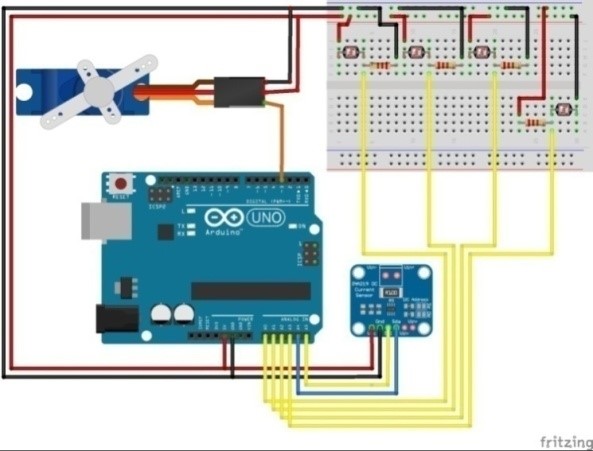Optimasi Efisiensi Solar Cell Melalui Solar Tracking dan Sistem Monitoring Pada Proteksi Energi Listrik
DOI:
https://doi.org/10.63440/jef.v1i1.19Keywords:
INA219 Sensor Module, Efficiency, Energy Storage Protection, Light Dependent Resistor (LDR)Abstract
This research aims to design and develop an advanced monitoring system for solar cells, incorporating solar tracking technology and equipped with an energy storage protection system. In Indonesia, the substantial potential of solar energy remains underutilized, despite the country's advantageous equatorial location, which provides a solar radiation intensity averaging 4.5 kWh/m² per day. The proposed system in this study seeks to maximize solar energy capture by employing a tracking mechanism that aligns the solar cells with the direction of sunlight throughout the day. Additionally, the system is designed with an integrated protection feature to prevent battery overuse, thereby extending the battery's lifespan and ensuring efficient energy storage. The research utilizes an Arduino Uno microcontroller, Light Dependent Resistor (LDR) sensors, and an INA219 sensor module as the primary components for accurate measurement and real-time monitoring. The system's effectiveness is evaluated based on its ability to optimize solar energy reception and maintain the longevity and efficiency of the energy storage system. Experimental results demonstrate that the developed system significantly improves the efficiency of solar energy capture by the solar cells and provides robust protection for the energy storage mechanism. This study contributes to the field of renewable energy by offering a practical solution for enhancing solar energy utilization in regions with high solar irradiance, thus promoting sustainable energy practices and reducing dependence on non-renewable energy sources.
Downloads
References
B. Budiono, I. B Sulistiawati, and N. P. Agustini, “Penggunaan NRF24L01 Untuk Monitoring Data Pada PLTS Kapasitas 309 WP,” J. FORTECH, vol. 4, no. 1, pp. 1–6, 2023, doi: https://doi.org/10.56795/fortech.v4i1.4101
M. R. Al Haqq, I. Chlissodin, and A. A. Soebroto, “Maximum Power Point Tracking (MPPT) pada Panel Surya dalam Kondisi Berbayang Sebagian dengan Particle Swarm Optimization (PSO),” Pengemb. Teknol. Inf. dan Ilmu Komput., vol. 5, no. 8, pp. 3524–3537, 2021. Available online: https://j-ptiik.ub.ac.id/index.php/j-ptiik/article/view/9607
H. Abdillah, T. Asrori, M. A. Baihaqi, D. H. T. Prasetyo, and A. Muhammad, “Sistem Monitoring dan Manajemen Energi pada Pembangkit Hybrid PLTS, PLTB, dan PLN berbasis Internet of Things,” JASIEK (Jurnal Apl. Sains, Informasi, Elektron. dan Komputer), vol. 5, no. 2, pp. 41–50, 2023, doi: https://doi.org/10.26905/jasiek.v5i2.10920
R. A. Diantari, S. Rahayu, and R. Okvasari, “Analisis Instalasi Listrik Menggunakan Pembangkit Listrik Surya Skala Rumah Tangga,” J. Ilm. Sutet, vol. 8, no. 2, pp. 122–128, 2018. Available online: https://www.neliti.com/id/publications/538499/
E. Unit Three Kartini, Bambang Suprianto, “Sistem Monitoring dan Pengukuran Pembangkit Listrik Surya dan Angin Berbasis Internet of Things Sistem Monitoring dan Pengukuran Pembangkit Listrik Surya dan Angin Berbasis Internet of Things (IoT),” J. Tek. Elektro, vol. 11, no. 3, pp. 371–378, 2022. doi: https://doi.org/10.26740/jte.v11n3.p371-378
H. Abdillah, A. N. Afandi, Aripriharta, Y. Rahmawati, M. Z. Falah, and G. Fujita, “Monitoring The Potential of Horizontal Axis Wind Power Plants Based on The Internet of Things,” AIP Conf. Proc., vol. 2926, no. 1, pp. 1–10, 2024, doi: https://doi.org/10.1063/5.0183360
Fransiscus Xaverius Ariwibisono and Widodo Pudji Muljanto, “Implementasi Sistem Monitoring Produksi Energi Plts Berbasis Protokol Modbus Rtu Dan Modbus Tcp,” Nuansa Inform., vol. 17, no. 2, pp. 109–118, 2023, doi: https://doi.org/10.25134/ilkom.v17i2.28
D. Liestyowati, I. Rachman, E. Firmansyah, and Mujiburrohman, “Rancangan Sistem Pembangkit Listrik Tenaga Surya (PLTS) Berkapasitas 100 WP dengan Inverter 1000 Watt,” INSOLOGI J. Sains dan Teknol., vol. 1, no. 5, pp. 623–634, 2022, doi: https://doi.org/10.55123/insologi.v1i5.1027
R. Sunky and R. Mukhaiyar, “Implementasi Web SCADA Pada Sistem PLTS,” JTEIN J. Tek. Elektro Indones., vol. 4, no. 2, pp. 792–798, 2023, doi: https://doi.org/10.24036/jtein.v4i2.510
Safri Nahela, Ivan Fauzi Faridyan, Noviadi Arief Rachman, Agus Risdiyanto, and Bambang Susanto, “Analisa Unjuk Kerja Grid Tied Inverter Terhadap Pengaruh Radiasi Matahari dan Temperatur PV pada PLTS On Grid,” Elkha, vol. 11, no. 2, pp. 60–65, 2019. doi: https://doi.org/10.26418/elkha.v11i2.31452
M. Farhan Fernanda et al., “Penentuan Komponen Sistem PLTS 100 Wp pada Floating Photovoltaic sebagai Sumber Energi Lampu Penerangan 20 W Pada Kolam Politeknik Negeri Jakarta,” Pros. Semin. Nas. Tek. Mesin Politek. Negeri Jakarta, pp. 171–180, 2021. Available online: http://prosiding-old.pnj.ac.id/index.php/sntm/article/view/4005
Y. Afrida, Jeckson, and D. Feriyanto, “Perencanaan Pembangkit Listrik Tenaga Surya on Grid,” Aisyah J. Informatcs Electr. Eng., vol. 4, no. 1, pp. 74–77, 2022. Available online: https://ejournal.uin-suska.ac.id/index.php/SNTIKI/article/view/3360
Lisiani, A. Razikin, and Syaifurrahman, “Identifikasi dan Analisis Jenis Beban Listrik Rumah Tangga Terhadap Faktor Daya (Cos Phi),” J. Untan, vol. 1, no. 3, pp. 1–9, 2020. doi: https://doi.org/10.26418/j3eit.v8i1.38675
S. Azmi, Y. Away, and I. Devi Sara, “Kajian Aspek Kecepatan dan Ketepatan pada Sun Tracker Dua Sumbu Berbasis Sensor Berbentuk Tetrahedron,” J. Rekayasa Elektr., vol. 15, no. 2, Sep. 2019, doi: https://doi.org/10.17529/jre.v15i2.13546
J. Rezkyanzah, L. P. Purba, and C. A. Putra, “Perancangan Solar Tracker Berbasis Arduino Sebagai Penunjang Sistem Kerja Solar Cell Dalam Penyerapan Energi Matahari,” SCAN J. Teknol. dan Komun., vol. XI, no. 2, pp. 55–60, 2016. doi: https://doi.org/10.33005/scan.v11i2.646
J. Wu, X. Chen, and L. Wang, “Design and Dynamics of a Novel Solar Tracker with Parallel Mechanism,” IEEE/ASME Trans. Mechatronics, vol. 21, no. 1, pp. 88–97, Feb. 2016, doi: https://doi.org/10.1109/TMECH.2015.2446994
Y. R. Al-Saadi, M. S. Tapou, A. A. Badi, S. Abdulla, and M. Diykh, “Developing Smart Self Orienting Solar Tracker for Mobile PV Power Generation Systems,” IEEE Access, vol. 10, pp. 79090–79099, 2022, doi: https://doi.org/10.1109/ACCESS.2022.3194026
C. D. Rodriguez-Gallegos, O. Gandhi, S. K. Panda, and T. Reindl, “On the PV Tracker Performance: Tracking the Sun Versus Tracking the Best Orientation,” IEEE J. Photovoltaics, vol. 10, no. 5, pp. 1474–1480, Sep. 2020, doi: https://doi.org/10.1109/JPHOTOV.2020.3006994
H. Fathabadi, “Novel online sensorless dual-axis sun tracker,” IEEE/ASME Trans. Mechatronics, vol. 22, no. 1, pp. 321–328, Feb. 2017, doi: https://doi.org/10.1109/TMECH.2016.2611564
T. V. Tran and W. Y. Chung, “High-Efficient Energy Harvester with Flexible Solar Panel for a Wearable Sensor Device,” IEEE Sens. J., vol. 16, no. 24, pp. 9021–9028, Dec. 2016, doi: https://doi.org/10.1109/JSEN.2016.2616114
J. A. Carrasco, F. G. De Quiros, H. Alaves, and M. Navalon, “An analog maximum power point tracker with pulsewidth modulator multiplication for a solar array regulator,” IEEE Trans. Power Electron., vol. 34, no. 9, pp. 8808–8815, Sep. 2019, doi: https://doi.org/10.1109/TPEL.2018.2886887

Downloads
Published
Issue
Section
License
Copyright (c) 2024 Mas Ahmad Baihaqi, Hartawan Abdillah, Ahmad Izzuddin, Tamam Asrori, Alief Muhammad, Dani Hari Tunggal Prasettio (Author)

This work is licensed under a Creative Commons Attribution-ShareAlike 4.0 International License.









